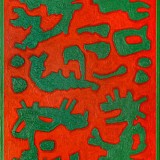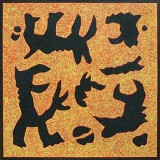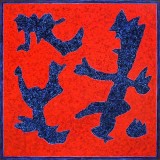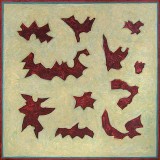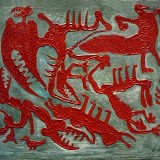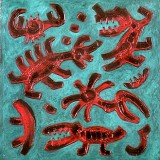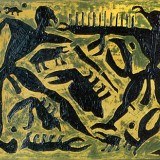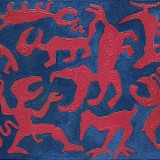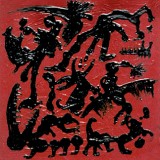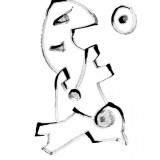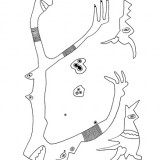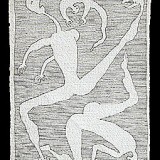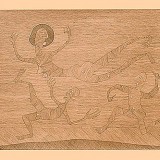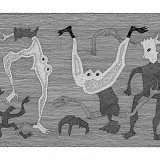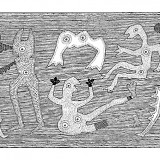Jan Grzegorz Issaieff
Born in 1953 of Russian origin. A self-taught poet, (during the 70s and 80s) and since the late 70s working in the media of painting and drawing. He has published his poems in Osnowa, Odgłosy and Radar. He rarely exhibits. His most important solo exhibition entitled Jan Grzegorz Issaieff – A.R.C.H.E. took place in Rempex (Warszawa 2007) and he also exhibited in a group show entitled Facing Apocalypse. The Kiss of Death, Galeria Bielska BWA (1999).
Since the beginning of his visual art work, beginning during the late 80s the artist has developed just two series A.R.C.H.E–DANCE (figuration) and Mystery (abstraction), and lately he attaches less importance to his second series. He considers himself a traditional painter. He looks with suspicion at the majority of output from the academic and post-avant-garde art.
His entire artistic approach is not only a question about painting and its essential features but also providing convincing response to it, which today is extremely hard. Painting is for him a form of spiritual activity, which is historically changeable, but unchangeable in the case of penetrating the mystery of being in a religious sense, following an aspect of the tradition of an icon, but developed also under the influence of modernity, which for a sacral function adopted abstract elements (as with Jerzy Nowosielski) or expressionist form as well as surrealist elements. Issaieff is not closed in an ivory tower. He tries to be open towards all postulates of modernity if there is an intellectual and spiritual space (such as Mark Rothko).
His paintings are the result of hard and long-lasting work, which can be compared with the kind of exercises from far-eastern calligraphy. The artist searches for one perfect form, which would be fulfilled in a defined spiritual way. He created his own iconography and formal system in which there are both anthropoids, resembling animals, and also those with features of higher beings (angels) and the infernal. The artist very aptly uses colour contrasts and multi-layering and value, although the works are consciously simplified and deprived of perspective, which together make a very specific and original style.
For a brief observer Issaieff is either a late „neue wilde” (painting) or in drawing, an artist continuing the tradition of Jan Dobkowski. Issaieff is above all a very consequent painter and drawer. In his art there are a lot of intriguing problems hidden, lyricism to begin with, and a predatory surreal grotesqueness, which resembles in aspects some work by Victor Brauner. Some of the theoreticians and artists treat “return to the roots” seriously, others ironically or as a mockery, as a formula close to the tradition of Neue Wilde. By operating with grotesque approaches Issaieff recalls in his mind a world which he addresses in an engaged and serious way, thinking that towards any kind of art an artist must be humble. His drawings present a rationalised, usually abstract background which resembles the experiences of constructivism (Stanisław Fijałkowski) who also searched for a spiritual calming down and recalling of literary symbolism. Sometimes the use of element of text appears, a constant word-ornament, rarely expressive but equally refined with contrasts of black and white. The world of A.R.C.H.E. is not complicated – a woman and a man facing primary gods and demons continue to fight for domination. One cannot exist or live without the other. They need each other because according to primary myths they come from the same ancient essence (the Androgyne myth). The women creatures can be dangerous, equipped with predatory jaws and hooks. The men on the other hand are marked with sexual power.
The artist for years aptly avoids ideological and formal contradictions, as he would like to stay at the ground level of art in its perennial sense and for him – the only sense. Observing the development of Jan G. Issaieff’s art, we notice a rarely seen consequence which is about a methodical analysis of the essence of painting. Namely in every painting he achieves new formal effects. They are very important but they also express, as much as it’s possible, a philosophical message about the presentation of an existential dialogue which he found in the writings of Martin Buber, included in the book Problem of a man.
In my opinion he is not neo-Gnostic, but rather a tender and surprisingly lively interpreter of the ideas of Mircea Eliade’s anthropology of culture, which expresses primary myths. He desires to show reality through a grotesque perspective. His art in a rare, but maybe the only way, attempts to connect seemingly excluding artistic problems. The fascination with the icon of the Orthodox Church is connected, (as in the case of Jerzy Nowosielski), with the search of new ideological problems. By using constructivist experiences of the type of Stanisław Fijałkowski, (including Strzemiński’s unism), Issaieff causes its paintings to act with a pulsing form based most often on colour dissonances, and refined tones of white. Of course Issaueff’s art is rather different than Strzemiński’s, but when it comes to the penetration of the idea of painting, they reached similar conclusions, in which each centimetre of painted canvas counts, as it is intended to have an effect on the viewer.
His paintings are convincing when it comes to their universal topics – the eternal competition of male and female elements and the ferocious fight which could be summarised by the conclusion expressed by Francis Bacon, that the world is Evil. Issaieff desires to make an alchemic change,. This change is not about justifying the eternal principle of Evil, but alternatively an attempt to change Evil into Goodness, of course, if it is at all possible.
Krzysztof Jurecki
The artist’s web site:
http://www.issaieff.com/


